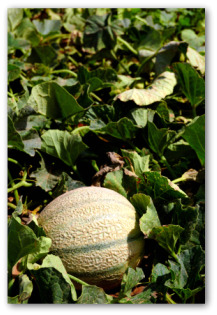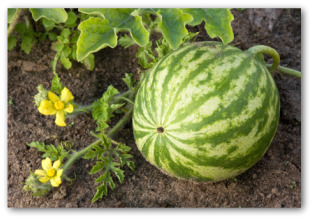Growing Melons, Growing Watermelons, How to Grow Melons

The best tips for growing melons including watermelon, in your backyard vegetable garden. Learn how to grow watermelon, muskmelon (Cantaloupes), winter melons when home gardening.
Design Your Own Vegetable Garden Layout Using our Free "Vegetable Garden Planner" Software!
The superior taste of vine-ripened fruit is well worth the extra effort it takes with melons.
The plants naturally pack up on sugar during its final days of growth before harvest.
This sweetness is noticeably missing in commercial brand melons, which are picked green for shipping.
Melons need nutrient rich soil, lots of sunlight, and at least 3-4 months of warm weather conditions.
The plants that produce melons, a vine of the gourd family, need quite a bit of room to grow.
For example, a single watermelon vine, can sprawl across 100 square feet and only produce two juicy fruits.
On the other hand, a 16-square foot area can provide dozens of sweet fruits.
Download Free Garden Planning Worksheets, Garden Diary, Zone Chart, Or Planting Guide
Types of Melons to Grow: Watermelons, Cantaloupes (Muskmelons), Winter Melons
- For gardeners with limited vegetable gardening space, try melons such as the compact bush cultivars.
Alternatively, grow standard types vertically on a strong trellis or fence.
What are usually call cantaloupes are actually muskmelons.
Winter melons (also a type of muskmelon) ripen as the weather starts to cool and will keep for long periods if stored properly.
This group includes honeydews, crenshaws, casabas, and Persians.
Growing Watermelons
Watermelons fall under a different botanical classification yet thrive under the same cultural conditions that other melons require.
Watermelons are now offered in compact growing cultivars or plants that are perfectly sized for smaller vegetable gardens.
There are also seedless cultivars on the market that produce firm, delicious fruits.
Planting Melons and Watermelons in Your Garden

- Melons including watermelons, need the sunniest spot possibly with
plenty of air circulation to help them dry out quickly after rain and
prevent diseases.
- Melon roots typically extend from 2" to 10" into the ground although some types go as deep as 4' -5'.
- The soil must be loose, retain moisture, but well drained for growing melons.
- Since they are generally one of the last crops planted in the vegetable garden, give them an extra boost by working 2"-3" of aged manure or compost into the planting area.
Melons Prefer Growing in Warm Soil
- Wait until the soil has warmed to 70-80 degrees F before planting melons.
- To get a head start, plant melon seed indoors in 4" peat pots, 2-4 weeks before transplanting.
- Sow several seeds ½" deep in each pot.
- Place pots in south-facing windows or other sunny spots.
- Harden off the seedlings a few days before planting time.

- Most melons grow better in hills. Raised mounds or hills provide warm soil and good drainage to growing melons.
- Depending on the cultivar, space hills 4' -6' apart;
vigorous growers like watermelons, may require 6' -12' between hills,
while bush types need only 2'.
- Work an extra shovelful of compost into each 1' high, 2'-3' wide hill just before planting.
- When planting melons directly in the
vegetable garden, sow six seeds per hill no earlier than two weeks after
the last frost date.
- In colder regions, put down a sheet of black plastic a few weeks prior to planting which warms up the soil.
Banana Cantaloupe
Banana cantaloupe is ready for harvest in 90 days.
Exceptionally sweet, and spicy, its flesh is vibrant salmon colored.
These unique melons grow up to 24 inches long, and are shaped somewhat like an oversized banana.
Growing Guidelines

- As plants begin to vine, apply mulch several inches thick to deter weeds and help growing melons stay clean and disease free.
- Water generously, especially right after transplanting and as fruit develops.
- Fertilize the melons with manure tea when the fruits set and again two weeks later.
Trivia: Spittin' Distance
Former world champ Lee Wheelis, once sent a watermelon seed sailing 68 feet 9-¼ inches in a seed-spitting contest!

